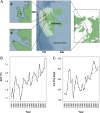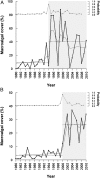Climate-driven regime shifts in Arctic marine benthos
- PMID: 22891319
- PMCID: PMC3435174
- DOI: 10.1073/pnas.1207509109
Climate-driven regime shifts in Arctic marine benthos
Abstract
Climate warming can trigger abrupt ecosystem changes in the Arctic. Despite the considerable interest in characterizing and understanding the ecological impact of rapid climate warming in the Arctic, few long time series exist that allow addressing these research goals. During a 30-y period (1980-2010) of gradually increasing seawater temperature and decreasing sea ice cover in Svalbard, we document rapid and extensive structural changes in the rocky-bottom communities of two Arctic fjords. The most striking component of the benthic reorganization was an abrupt fivefold increase in macroalgal cover in 1995 in Kongsfjord and an eightfold increase in 2000 in Smeerenburgfjord. Simultaneous changes in the abundance of benthic invertebrates suggest that the macroalgae played a key structuring role in these communities. The abrupt, substantial, and persistent nature of the changes observed is indicative of a climate-driven ecological regime shift. The ecological processes thought to drive the observed regime shifts are likely to promote the borealization of these Arctic marine communities in the coming years.
Conflict of interest statement
The authors declare no conflict of interest.
Figures




References
-
- Comiso JC, Parkinson CL, Gertsen R, Stock L. 2006. Accelerated decline in the Arctic sea ice cover. Geophy Res Lett 33:L18504.
-
- Qu B, Gabric AJ, Matrai PA. The satellite-derived distribution of chlorophyll-a and its relation to ice cover, radiation and sea surface temperature in the Barents Sea. Polar Biol. 2006;29:196–210.
-
- Arrigo KR, van Dijken G, Pabi S. Impact of a shrinking Arctic ice cover on marine primary production. Geophys Res Lett. 2008;35:L19603.
-
- Rodrigues J. The increase in the length of the ice-free season in the Arctic. Cold Reg Sci Technol. 2009;59:78–101.
Publication types
MeSH terms
LinkOut - more resources
Full Text Sources
Medical

